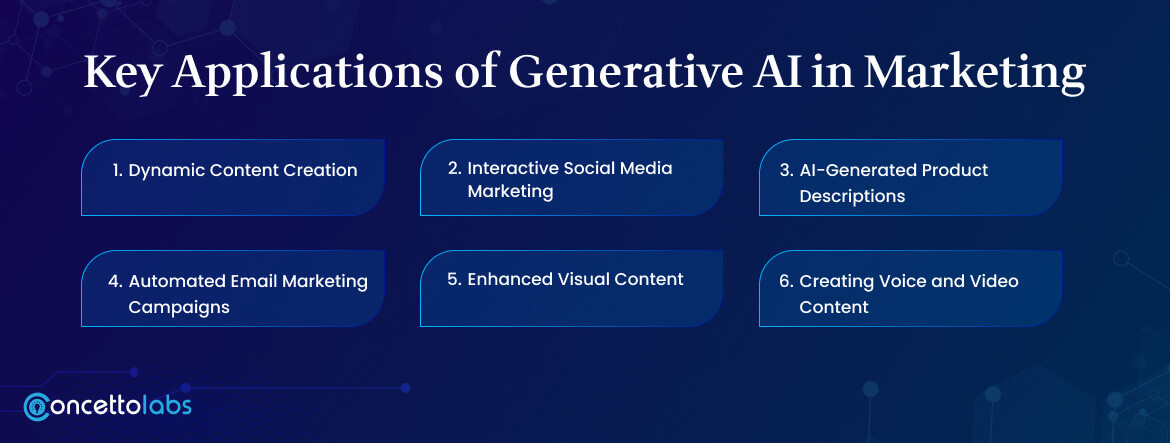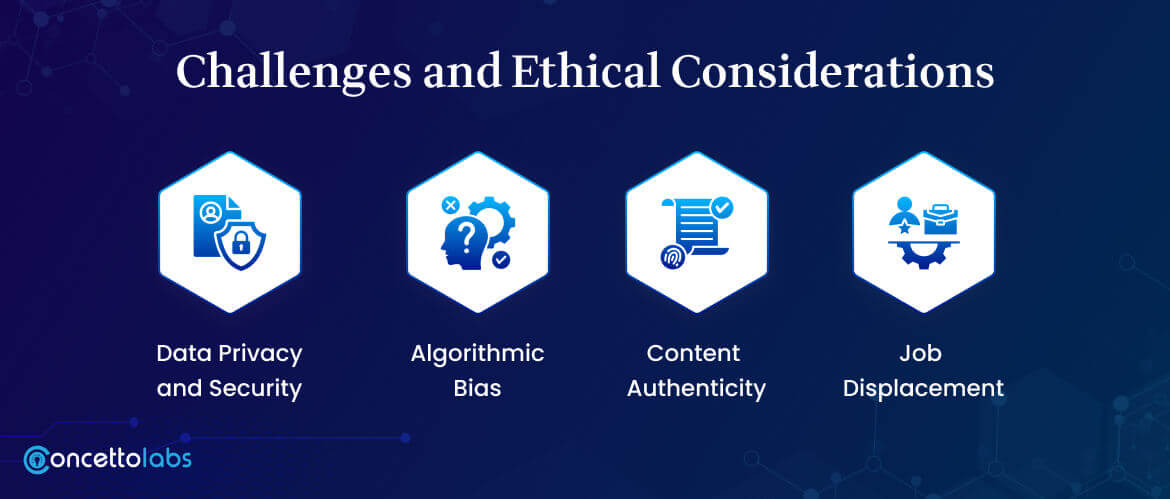
Table of Contents
Marketing is no longer an art of creating enticing campaigns and relying on instincts. The new economy is characterized by evidence-based information with technology performance indicators being innovative and providing measurable, durable, and reproducible outcomes. One of the most groundbreaking technology boons of the modern era is Generative AI, which has become the key enabler as the tool for businesses to create, implement and quantify marketing plans.
As more and more marketers turn to Generative AI, companies are reconsidering how they get customers, make content, and run campaigns. In this blog, we will look at how generative AI is specifically impacting the marketing industry, the opportunities that it offers, use cases, tools, and considerations, as well as the best way businesses can fully unlock the potential of generative AI.
Benefits of Generative AI in Marketing

With generative AI, marketers are introduced to unprecedented benefits in the contemporary world. Apart from the time and resources their campaigns consume, it helps them design efficient and highly targeted campaigns. Let’s dive deeper into these benefits:
1. Hyper-Personalization at Scale
The generative AI capability empowers marketers to engage millions of customers with highly customized interactions at the same time. Using customer’s information about behavior, needs and buying habits AI can create unique mailings, pages or even certain product recommendations. For example, self-driving ads that automatically alter in front of a user’s eyes yield significantly higher conversion rates.
2. Effective Communication for Multichannel Marketing
Today’s customer engages with a brand through email, social media, websites, mobile apps, and many other channels. Although employed in various forms throughout marketing, generative AI finds its biggest application in the formulation of a unified multichannel campaign wherein similar content is fed to all platforms with the content customized for each of those platforms.
3. Forecast and Self-Organization
Operational AI entails using generative analysis of past campaigns to estimate results and check such findings with proposals for changes. It allows marketers to change the approaches of a campaign in a timely manner for the most effective results. For instance, it can show which product images or CTAs (calls to action) are more likely to elicit positive results with a target market.
4. Faster Content Generation
One of the major problems marketers face is how to come up with new and innovative content over and over again. AI can write blogs, videos, infographics, and ad copies in minutes reducing the amount of time taken and the costs incurred while producing top-quality content.
5. Boosting ROI
From improving ad targeting to eliminating repetitive tasks, Generative AI helps uplift the conversion of marketing dollars for better ROI. By automating several processes, marketers are able to spend more time addressing more value-added processes that have more value in the business.
Key Applications of Generative AI in Marketing

The opportunities of using generative AI development for marketing are numerous and on a steady increase as we speak. Let’s take a closer look at how businesses are utilizing this technology.
1. Dynamic Content Creation
If you’re using tools for generating content, such as Jasper AI or Writesonic, you can even get blogs, ad copy, or even an entire blog post written for a specific buyer persona. This is beneficial most especially for marketers who wish to be able to suffice the constant rising need for relatable quality content.
2. Interactive Social Media Marketing
To reply to customers, servicing social media accounts is usually timely and involves engaging with customers. ChatGPT as a generative AI tool can be of great use to social media managers as it can provide them with individualized replies to customers’ comments and inquiries within the shortest time while maintaining a high engagement level.
3. AI-Generated Product Descriptions
It must be emphasized that it is very beneficial for e-commerce companies to employ AI for generating product descriptions. With generative AI, the company can generate appealing and unique descriptive content for thousands of SKUs in a much shorter time than with actual teams.
4. Automated Email Marketing Campaigns
Marketing generative AI to help business organizations in sending emails to customers based on their behavior. For instance, it can send cart abandonment messages for e-commerce visitors or alert the client of related products to purchase according to their past orders.
5. Enhanced Visual Content
Tools such as DALL-E and the recently announced Adobe Firefly can generate images that fit marketing campaigns. Regardless of whether it is social media visuals or images, infographics or display ads, AI guarantees speed and originality.
6. Creating Voice and Video Content
Leveraging Generative AI, tools like Synthesia help marketers to make AI-generated voice-overs and videos to make videos for their campaigns within no time and in an affordable manner.
Practical Examples of Generative AI in Action

For now, let’s look at the non-hypothetical ways Generative AI is significantly altering marketing and businesses in general. Here are some real-world applications:
1. Personalized Playlists at Spotify
The best-known examples of outstanding AI usage are particular lists that give users recommendations based on preferences including ‘Discover Weekly.’ This in turn makes the user more productive and ultimately loyal to the company or product.
2. Domino’s Pizza Chatbot
Domino’s uses an artificial intelligence chatbot known as Dom to take orders and help customers through text or voice. This best practice makes for good customer returns as well as having a fewer charge as compared to the primitive cumbersome process.
3. Unilever’s Ad Optimization
Unilever is currently using AI to trial several different ad creatives and determine which one will appeal to different audiences the most. As a result, there has been enhanced ROI on its digital ad media.
4. The New York Times Automated Summaries
I found that the New York Times has implemented Chem AI in an effort to generate summaries of news articles to compensate for the users’ inability to quickly get the gist of an article. This has improved user satisfaction and increased the number of users that return to read more content.
Tools and Technologies for Generative AI Marketing
Fortunately, there is a multitude of tools that can be employed, to leverage Generative AI, for marketing. Here’s an expanded list.
- ChatGPT (OpenAI): Especially appropriate for most small talk and customer-oriented applications as well as brainstorming sessions.
- Jasper AI: Favourite: writing SEO-friendly text for websites, ads, and marketing newsletters.
- MidJourney & DALL-E: Create great visuals and graphics that would complement a campaign.
- HubSpot AI: Supports CRM and Marketing automation utilizing Artificial Intelligence.
- Synthesia: Creates videos with AI characters having selectable appearances.
- MarketMuse: Helps to develop an AI-driven message and offers an AI-based SEO suggestion.
It also takes creative work from repetitive routine work and thus assists businesses to function effectively in a highly dynamic technological market.
Challenges and Ethical Considerations

While Generative AI has immense potential, it’s important to be aware of its challenges and ethical implications.
1. Data Privacy and Security
AI operates on data and so if customer data is utilised in a wrong way, it will lead to a breach or infringement of rules such as GDPR. Marketers can consequently need to make sure that data is administered safely.
2. Algorithmic Bias
These negative consequences can stem when AI produces sentiments that are mine from the training data set, in a manner that biases a certain result or is not proper.
3. Content Authenticity
Automation of content for biography may not incorporate the use of emotional appeal which is sometimes essential in marketing. There has to be a way to have both freedom and expert judgment in balance with well-executed optimization.
4. Job Displacement
In further discussion, the rise of AI may be seen as a potential threat due to reducing demand for specific positions. Employers need to pay more attention to preparing employees for collaboration with advanced technologies.
Also Read : What are the Challenges and Future Trends of Generative AI?
Best Practices for Leveraging Generative AI in Marketing

To fully utilize the potential of Generative AI, follow these best practices.
1. Start Small and Scale Gradually
Start by creating simple applications like recurring mailings or social media feeds and then move up to full-scale uses like statistical modeling.
2. Invest in Training
Make sure your team understands how to use AI tools to prevent instances in which they are used minimally. Awareness about practice is better created through training programs which in one way or another bring the gap between knowledge and skills.
3. Prioritize Transparency
Machine decision-makers should be identified when this is the case, especially when an organization is interacting with a client.
4. Test Regularly
It is essential to keep watch over the AI-based marketing campaigns to detect some level of bias error or inefficiency and make a necessary correction if the situation calls for it.
Looking for a Breakthrough in Your Marketing?
Start your journey today by incorporating Concetto Labs to fulfill your objectives and the AI tools you want to use.
The Future of Marketing with Generative AI
The future of marketing with Generative AI is brimming with possibilities.
- Real-Time Customer Insights: This will allow organizations to obtain real-time customer information that can be leveraged in near real-time to take action.
- Emotionally Intelligent AI: Innovations will be used to extend AI capabilities for mimicking human feelings so that the conversation becomes even deeper.
- Seamless Integration: Generative AI will not be an additive extra to any marketing applications and media, it will be an inherent part of each of them.
Table of Contents









 Indonesia
Indonesia
 Botswana
Botswana
 USA
USA
 Italy
Italy
 Panama
Panama














 USA
USA Canada
Canada UK
UK Norway
Norway India
India Australia
Australia